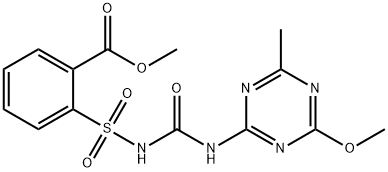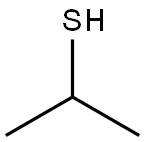2-Methyl-2-propanethiol
Synonym(s):tert-Butyl mercaptan;TBM
- CAS NO.:75-66-1
- Empirical Formula: C4H10S
- Molecular Weight: 90.19
- MDL number: MFCD00004857
- EINECS: 200-890-2
- SAFETY DATA SHEET (SDS)
- Update Date: 2024-12-18 14:15:32

What is 2-Methyl-2-propanethiol?
Description
tert-Butylthiol, also known as 2-methyl propane-2-thiol, 2- methyl-2-propane thiol, tert-butyl mercaptan (TBM), and t-BuSH, is an organo sulfur compound with the formula (CH3)3CSH. This thiol may have been used as a flavoring agent, as an odorant for natural gas (which is odorless), and also in a wide range of organic reactions.
Chemical properties
liquid with an exceedingly unpleasant smell
The Uses of 2-Methyl-2-propanethiol
2-Methyl-2-propanethiol was used in reaction of 2-methyl-2-propanethiol on Mo(110) using temperature programmed reaction, high resolution electron enegy loss and X-ray photoelectron spectroscopies. It was used in the synthesis of chain-transfer agents for reversible addition-fragmentation chain-transfer copolymerization of vinylidene chloride and methyl acrylate.
The Uses of 2-Methyl-2-propanethiol
Tert-Butylthiol is the main ingredient in many gas odorant blends. It is always utilized as a blend of other compounds, typically dimethyl sulfide, methyl ethyl sulfide, tetrahydrothiophene or other mercaptans (isopropyl mercaptan, sec-butyl mercaptan and/or n-butyl mercaptan, due to its rather high melting point of 273 K. These blends are used only with natural gas and not propane, as the boiling points of these blends and propane are quite different. As propane is delivered as a liquid and vaporizes to gas when being delivered to the appliance, the vapor liquid equilibrium would substantially reduce the amount of odorant blend in the vapor.
Tert - Butyl thiol has been listed on the European Food Safety Authority (FL-no: 12.174) as a flavor additive. There is no indication of what flavor or flavors it may have been used in. It has been removed from this list.
Preparation
tert-Butyl thiol likely does not occur naturally, but at least one publication has listed it as a very minor component of cooked potatoes. The compound was first prepared in 1890 by Leonard Dobbin by the reaction of zinc sulfide and t-butyl chloride.
The compound was later prepared in 1932 by the reaction of the Grignard reagent, t-BuMgCl, with sulfur to give the corresponding thiolate, followed by hydrolysis. This preparation is shown below:
t-BuMgCl + S → t-BuSMgCl
t-BuSMgCl + H2O → t-BuSH + Mg(OH)Cl
It is currently prepared industrially by the reaction of isobutylene with hydrogen sulfide over a clay (silica alumina) catalyst.
Reactions
tert-Butylthiol can react with metal alkoxides and acyl chlorides to form thiol esters, as shown in the equation :
In the reaction above, thallium (I) ethoxide converts to thallium (I) t-butyl thiolate. In the presence of diethyl ether, thallium (I) tbutylthiolate reacts with acyl chlorides to give the corresponding tertbutyl thioesters. Like other thio esters, it reverts back to tert-butylthiol by hydrolysis.
Lithium 2-methyl propane-2-thiolate can be prepared by treatment of tert-butyl thiol with lithium hydride in an aprotic solvent such as hexa methyl phosphorous triamide (HMPT). The resulting thiolate salt is a useful demethylating reagent. For example, treatment with 7- methyl guanosine gives guanosine. Other N-methylated nucleosides in tRNA are not demethylated by this reagent .
General Description
2-Methyl-2-propanethiol undergoes ring opening nucleophilic reaction with 3-isothiazolones and reaction kinetics studies suggested reaction was second order in thiol and third order overall.
Hazard
Flammable, dangerous fire risk. Very toxic.
Safety Profile
Moderately toxic by intraperitoneal route. Mildly toxic by ingestion. An eye irritant. A very dangerous fire hazard when exposed to heat or flame. Can react vigorously with oxidizing materials. To fight fire, use alcohol foam, dry chemical, mist, fog. When heated to decomposition or on contact with acid or acid fumes it emits highly toxic fumes of SOx.
Safety
Even in well ventilated areas, extreme caution must be made when handling tert-butylthiol as it is a highly odorous chemical with an odor threshold of < 0.33 ppb. Extreme caution is not due to toxicity, but due to the significant odor and concerns that this odor would cause to the many individuals that might be exposed. The PEL for thiols of most types is 500 ppb, primarily due to reaction of nausea at levels of 2–3 ppm. The LC50 of tert-butylthiol is much, much higher.
Purification Methods
Dry the thiol for several days over CaO, then distil it from CaO. Purify it as for 2-methylpropane-1-thiol above. [Beilstein 1 H 383, 1 II 416, 1 III 1589, 1 IV 1634.]
Metal complexes
The anion derived from tert – butyl thiol forms complexes with various metals. One example is tetra kis (tert-butyl thiolato ) molybdenum (IV), Mo(t-BuS)4. This complex was prepared by treating MoCl4 with t-BuSLi :
Mo Cl4 + 4t-Bu S Li → Mo (t-BuS)4 + 4LiCl
Mo(t-BuS)4 is a dark red diamagnetic complex that is sensitive to air and moisture. The molybdenum center has a distorted tetra hedral coordination to four sulfur atoms, with overall D2 symmetry.
Properties of 2-Methyl-2-propanethiol
| Melting point: | -1.1 °C |
| Boiling point: | 62-65 °C(lit.) |
| Density | 0.8 g/mL at 25 °C(lit.) |
| vapor density | 3.1 (vs air) |
| vapor pressure | 303.5 mm Hg ( 37.7 °C) |
| refractive index | n |
| Flash point: | −12 °F |
| storage temp. | Flammables area |
| solubility | 1.47g/l slightly soluble |
| form | Liquid |
| pka | pK1:11.22 (25°C,μ=0.1) |
| color | Clear colorless |
| Odor | sulfury |
| Odor Threshold | 0.000029ppm |
| Water Solubility | Slightly soluble in water |
| Merck | 14,1579 |
| BRN | 505947 |
| Dielectric constant | 5.4800000000000004 |
| Stability: | Stable. Flammable - note low flashpoint. Incompatible with strong oxidizing agents. |
| CAS DataBase Reference | 75-66-1(CAS DataBase Reference) |
| NIST Chemistry Reference | 2-Propanethiol, 2-methyl-(75-66-1) |
| EPA Substance Registry System | 2-Propanethiol, 2-methyl- (75-66-1) |
Safety information for 2-Methyl-2-propanethiol
| Signal word | Danger |
| Pictogram(s) |
 Flame Flammables GHS02  Exclamation Mark Irritant GHS07  Environment GHS09 |
| GHS Hazard Statements |
H225:Flammable liquids H317:Sensitisation, Skin H411:Hazardous to the aquatic environment, long-term hazard |
| Precautionary Statement Codes |
P210:Keep away from heat/sparks/open flames/hot surfaces. — No smoking. P233:Keep container tightly closed. P240:Ground/bond container and receiving equipment. P273:Avoid release to the environment. P280:Wear protective gloves/protective clothing/eye protection/face protection. P303+P361+P353:IF ON SKIN (or hair): Remove/Take off Immediately all contaminated clothing. Rinse SKIN with water/shower. |
Computed Descriptors for 2-Methyl-2-propanethiol
2-Methyl-2-propanethiol manufacturer
New Products
(S)-3-Aminobutanenitrile hydrochloride 4-Methylphenylacetic acid N-Boc-D-alaninol N-BOC-D/L-ALANINOL Tert-butyl bis(2-chloroethyl)carbamate 3-Morpholino-1-(4-nitrophenyl)-5,6-dihydropyridin- 2(1H)-one Furan-2,5-Dicarboxylic Acid Tropic acid 1-Bromo-3,5-Di-Tert-Butylbenzene S-2-CHLORO PROPIONIC ACID ETHYL ISOCYANOACETATE 2-Bromo-1,3-Bis(Dimethylamino)Trimethinium Hexafluorophosphate 4-IODO BENZOIC ACID 3-NITRO-2-METHYL ANILINE 1-(2,4-DICHLOROPHENYL) ETHANAMINE (2-Hydroxyphenyl)acetonitrile 4-Bromopyrazole 2-(Cyanocyclohexyl)acetic acid 4-methoxy-3,5-dinitropyridine 1-(4-(aminomethyl)benzyl)urea hydrochloride 2-aminopropyl benzoate hydrochloride diethyl 2-(2-((tertbutoxycarbonyl)amino) ethyl)malonate tert-butyl 4- (ureidomethyl)benzylcarbamate Ethyl-2-chloro((4-methoxyphenyl)hydrazono)acetateRelated products of tetrahydrofuran








You may like
-
 2-Methyl-2-propanethiol, 99% CAS 75-66-1View Details
2-Methyl-2-propanethiol, 99% CAS 75-66-1View Details
75-66-1 -
 tert-Butyl Mercaptan CAS 75-66-1View Details
tert-Butyl Mercaptan CAS 75-66-1View Details
75-66-1 -
 2-METHYL-2-PROPANETHIOL CAS 75-66-1View Details
2-METHYL-2-PROPANETHIOL CAS 75-66-1View Details
75-66-1 -
 2-Methyl-2-propanethiol CAS 75-66-1View Details
2-Methyl-2-propanethiol CAS 75-66-1View Details
75-66-1 -
 1975-50-4 98%View Details
1975-50-4 98%View Details
1975-50-4 -
 2-HYDROXY BENZYL ALCOHOL 98%View Details
2-HYDROXY BENZYL ALCOHOL 98%View Details
90-01-7 -
 14714-50-2 (2-Hydroxyphenyl)acetonitrile 98+View Details
14714-50-2 (2-Hydroxyphenyl)acetonitrile 98+View Details
14714-50-2 -
 118753-70-1 98+View Details
118753-70-1 98+View Details
118753-70-1